Towards the Development of Electrical Biosensors Based on Nanostructured Porous Silicon
Abstract
:1. Introduction
2. Experimental
2.1. Fabrication of Electrical Biosensors Based on Nanostructured Porous Silicon
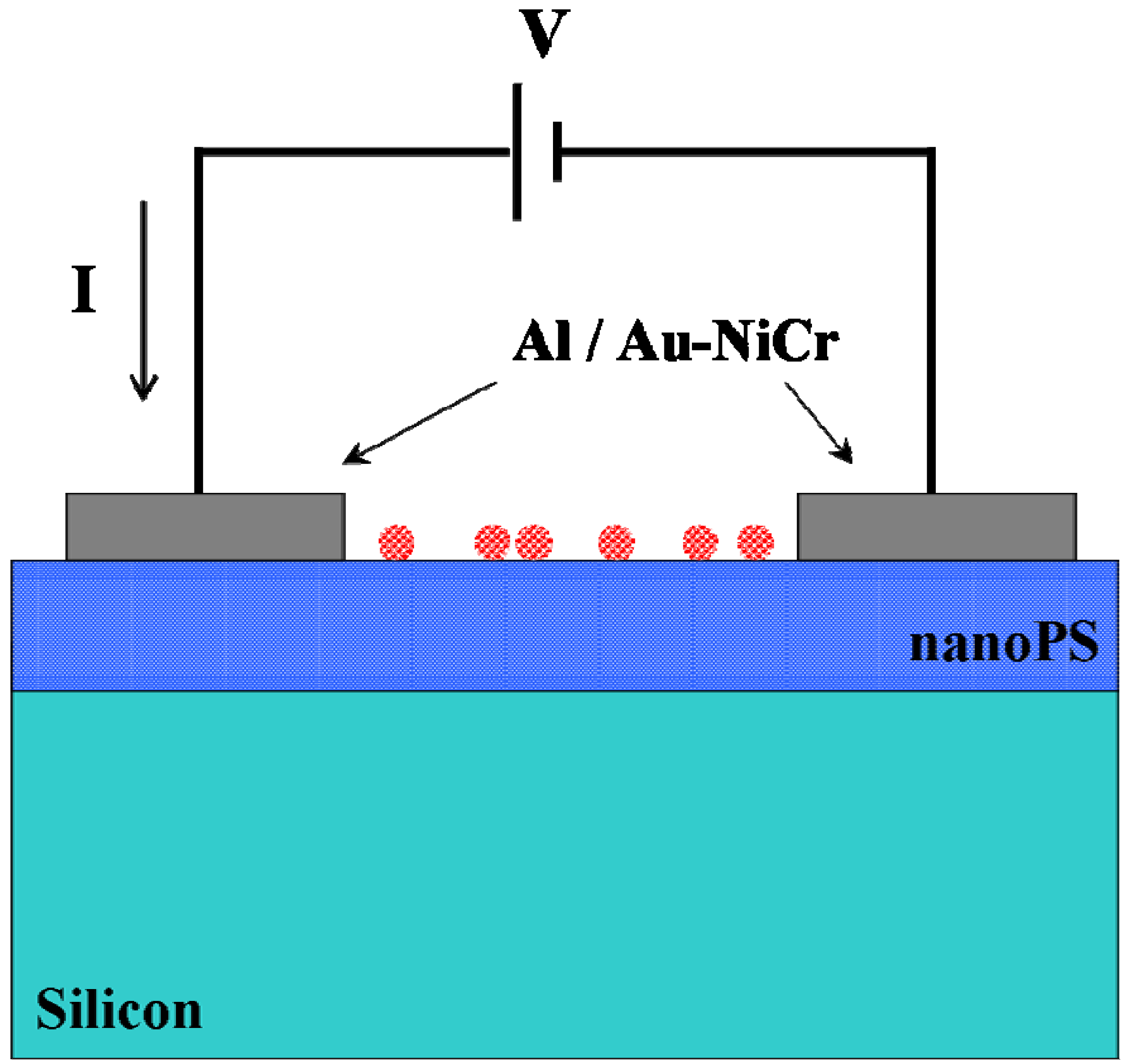
2.2. Immobilization of Glucose
2.3. Biofunctionalization and Immobilization of E. Coli
2.4. Electrical Characterization
3. Results
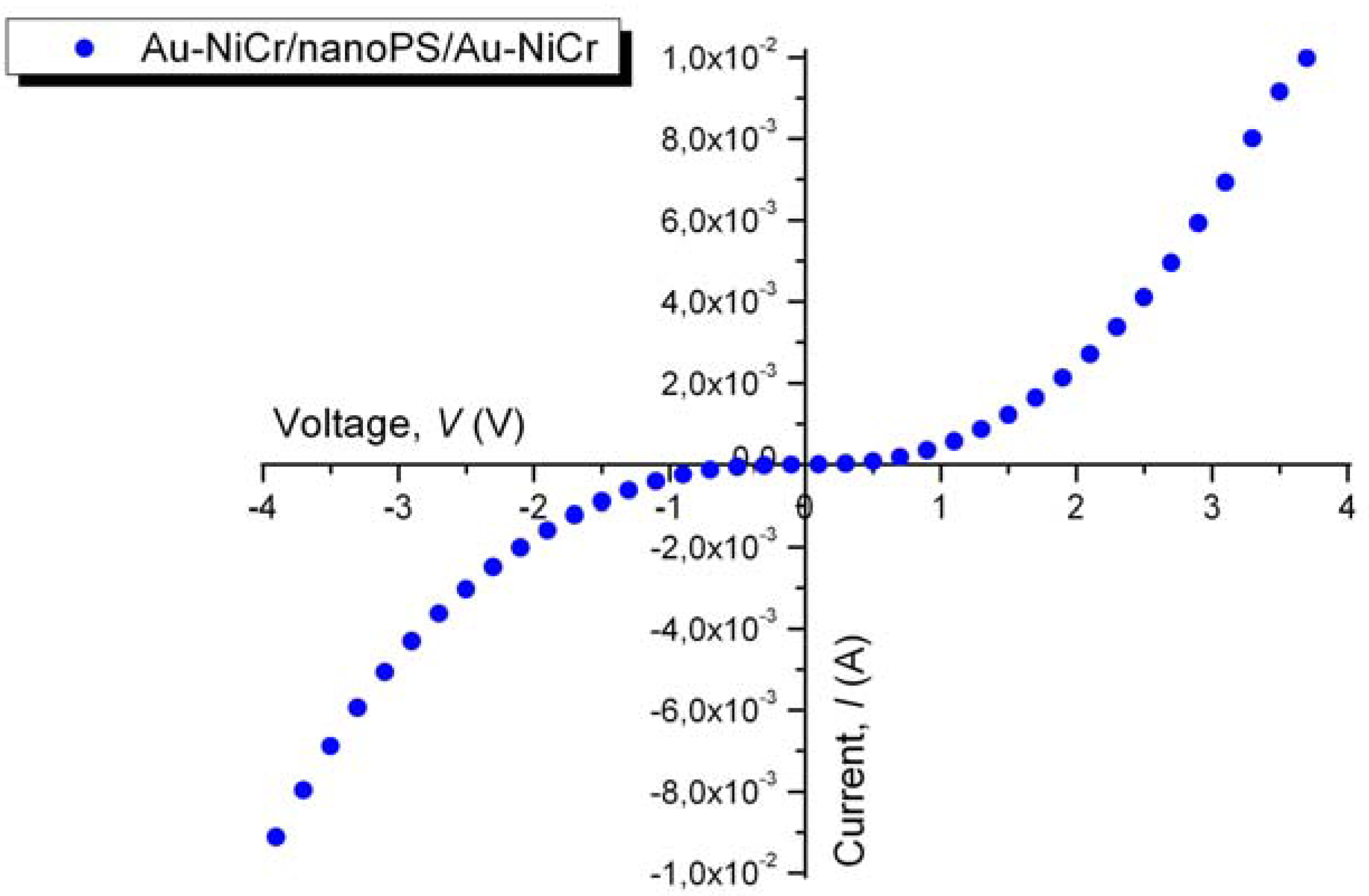
3.1. Electrical Biosensing of Glucose
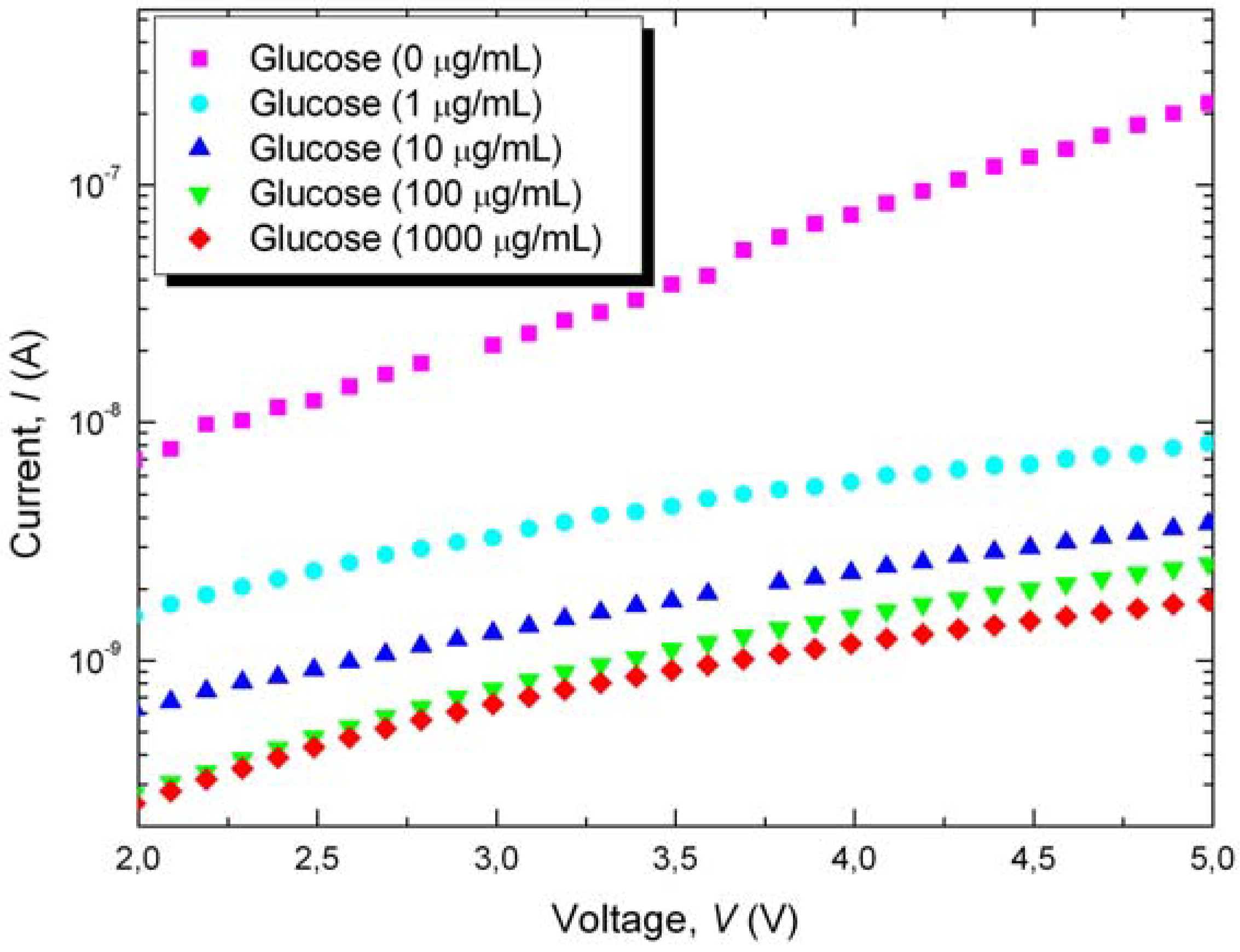
3.2. Electrical Biosensing of E. coli
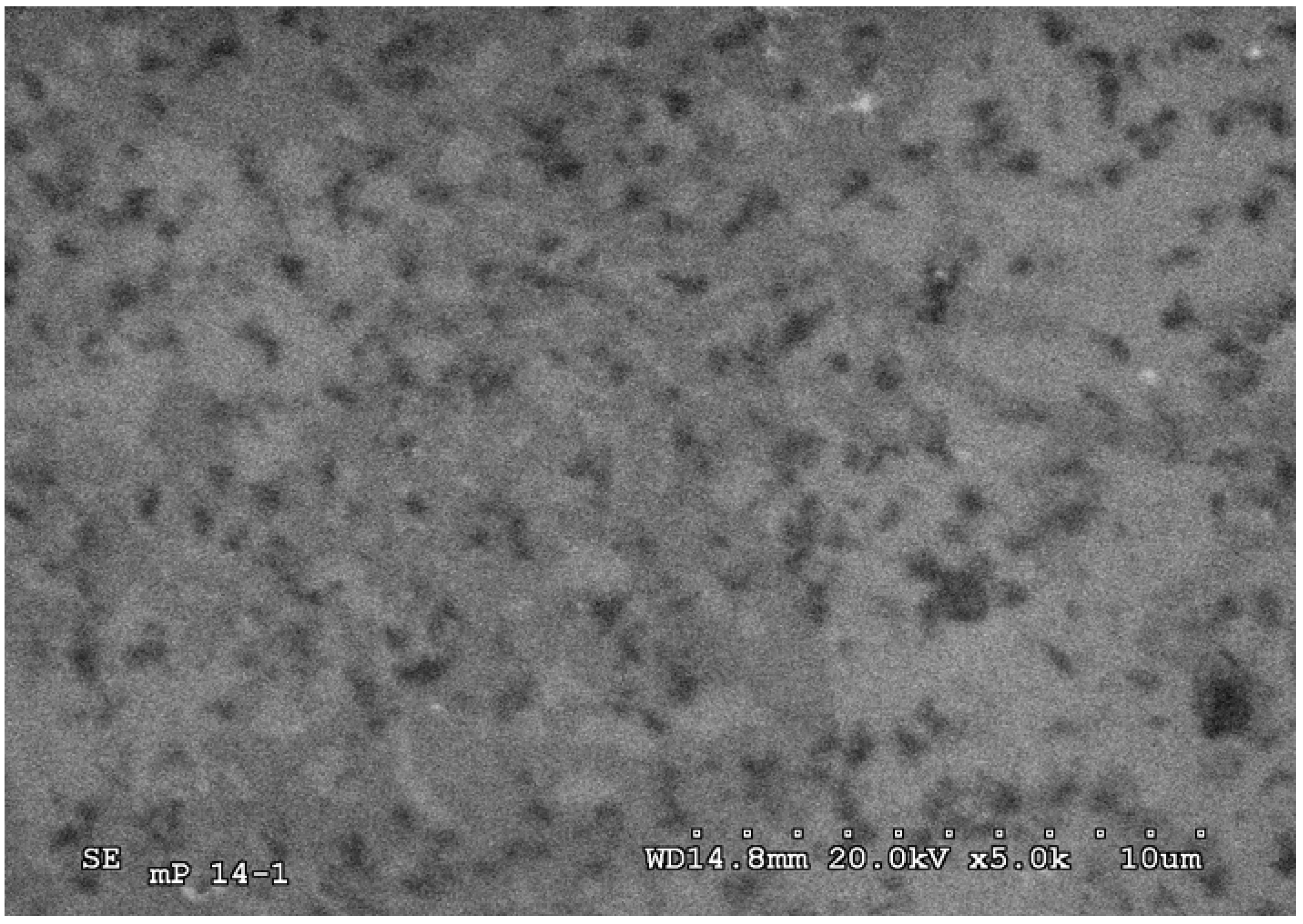
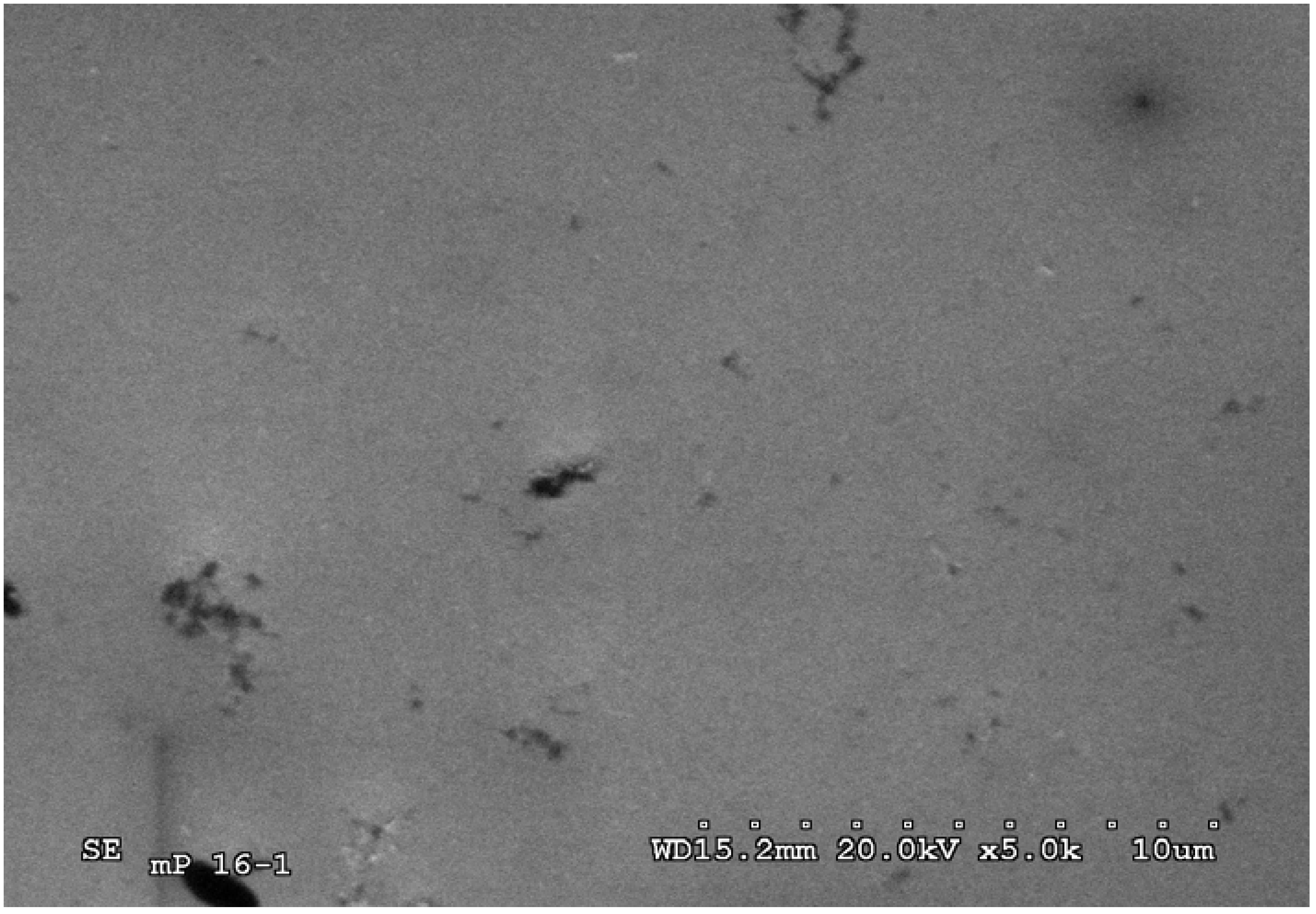

4. Conclusions
Acknowledgements
References
- Lehmann, V. Electrochemistry of Silicon: Instrumentation, Science, Materials and Applications; Wiley-VCH: Weinheim, Germany, 2002. [Google Scholar]
- Föll, H.; Christophersen, M.; Carstensen, J.; Hasse, G. Formation and application of porous silicon. Mat. Sci. Eng. R 2002, 39, 93–141. [Google Scholar] [CrossRef]
- Kochergin, V.; Foell, H. Novel optical elements made from porous Si. Mat. Sci. Eng. R 2006, 52, 93–140. [Google Scholar] [CrossRef]
- Martín-Palma, R.J.; Pascual, L.; Herrero, P.; Martínez-Duart, J.M. Direct determination of grain sizes, lattice parameters, and mismatch of porous silicon. Appl. Phys. Lett. 2002, 81, 25–27. [Google Scholar] [CrossRef]
- Pascual, L.; Martín-Palma, R.J.; Landa-Cánovas, A.R.; Herrero, P.; Martínez-Duart, J.M. Lattice distortion in nanostructured porous silicon. Appl. Phys. Lett. 2005, 87, 251921:1–251921:3. [Google Scholar] [CrossRef]
- Martín-Palma, R.J.; Pascual, L.; Herrero, P.; Martínez-Duart, J.M. Monte carlo determination of crystallite size of porous silicon from x-ray line broadening. Appl. Phys. Lett. 2005, 87, 211906:1–211906:3. [Google Scholar] [CrossRef]
- Cadet, C.; Deresmes, D.; Villaume, D.; Stievenard, D. Influence of surface defects on the electrical behavior of aluminum-porous silicon junctions. Appl. Phys. Lett. 1994, 64, 2827–2829. [Google Scholar] [CrossRef]
- Lehmann, V.; Hofmann, F.; Möller, F.; Gruning, U. Resistivity of porous silicon: A surface effect. Thin Solid Films 1995, 255, 20–22. [Google Scholar] [CrossRef]
- Balagurov, L.A.; Yarkin, D.G.; Petrova, E.A. Electronic transport in porous silicon of low porosity made on a p+ substrate. Mater. Sci. Eng. B 2000, 69–70, 127–131. [Google Scholar]
- López-García, J.; Martín-Palma, R.J.; Manso, M.; Martínez-Duart, J.M. Porous silicon based structures for the electrical biosensing of glucose. Sens. Actuat. B-Chem. 2007, 126, 82–85. [Google Scholar] [CrossRef]
- Chayen, N.E.; Saridakis, E.; El-Bahar, R.; Nemirovsky, Y. Porous silicon: An effective nucleation-inducing material for protein crystallization. J. Mol. Biol. 2001, 312, 591–595. [Google Scholar] [CrossRef] [PubMed]
- Canham, L.T. Bioactive silicon structure fabrication through nanoetching techniques. Adv. Mat. 1995, 7, 1033–1037. [Google Scholar] [CrossRef]
- Arroyo-Hernández, M.; Martín-Palma, R.J.; Pérez-Rigueiro, J.; García-Ruiz, J.P.; García-Fierro, J.L.; Martínez-Duart, J.M. Biofunctionalization of surfaces of nanostructured porous silicon. Mater. Sci. Eng. C 2003, 23, 697–701. [Google Scholar] [CrossRef]
- Arroyo-Hernández, M.; Martín-Palma, R.J.; Torres-Costa, V.; Martínez Duart, J.M. Porous silicon optical filters for biosensing applications. J. Non-Cryst. Sol. 2006, 352, 2457–2460. [Google Scholar] [CrossRef]
- Martin-Palma, R.J.; Manso, M.; Perez Rigueiro, J.; Garcia Ruiz, J.P.; Martinez Duart, J.M. Surface biofunctionalization of materials by amine groups. J. Mater. Res. 2004, 19, 2415–2420. [Google Scholar] [CrossRef]
- Martín-Palma, R.J.; Martínez-Duart, J.M.; Li, L.; Levy, R.A. Electrical behavior of double-sided metal/porous silicon structures for optoelectronic devices. Mater. Sci. Eng. C 2002, 19, 359–362. [Google Scholar] [CrossRef]
- Antonio, R.M.; Bianchini, I., Jr. Methodological tests of a heterotrophy index for aquatic ecosystems. Braz. J. Biol. 2003, 63, 373–380. [Google Scholar] [CrossRef] [PubMed]
- Ben-Chorin, M.; Kux, A.; Schechter, I. Adsorbate effects on photoluminescence and electrical conductivity of porous silicon. Appl. Phys. Lett. 1994, 64, 481–483. [Google Scholar] [CrossRef]
- Möller, F.; Ben-Chorin, M.; Koch, F. Post-treatment effects on electrical conduction in porous silicon. Thin Solid Films 1995, 255, 16–19. [Google Scholar] [CrossRef]
- Carstensen, E.L.; Cox, H.A., Jr.; Mercer, W.B.; Natale, L.A. Passive Electrical properties of microorganisms i. conductivity of Escherichia coli and micrococcus lysodeikticus. Biophys. J. 1965, 5, 289–300. [Google Scholar]
© 2010 by the authors; licensee Molecular Diversity Preservation International, Basel, Switzerland. This article is an open-access article distributed under the terms and conditions of the Creative Commons Attribution license (http://creativecommons.org/licenses/by/3.0/).
Share and Cite
Recio-Sánchez, G.; Torres-Costa, V.; Manso, M.; Gallach, D.; López-García, J.; Martín-Palma, R.J. Towards the Development of Electrical Biosensors Based on Nanostructured Porous Silicon. Materials 2010, 3, 755-763. https://doi.org/10.3390/ma3020755
Recio-Sánchez G, Torres-Costa V, Manso M, Gallach D, López-García J, Martín-Palma RJ. Towards the Development of Electrical Biosensors Based on Nanostructured Porous Silicon. Materials. 2010; 3(2):755-763. https://doi.org/10.3390/ma3020755
Chicago/Turabian StyleRecio-Sánchez, Gonzalo, Vicente Torres-Costa, Miguel Manso, Darío Gallach, Juan López-García, and Raúl J. Martín-Palma. 2010. "Towards the Development of Electrical Biosensors Based on Nanostructured Porous Silicon" Materials 3, no. 2: 755-763. https://doi.org/10.3390/ma3020755





